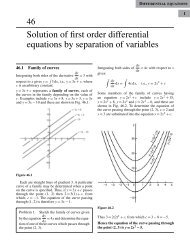integration
Create successful ePaper yourself
Turn your PDF publications into a flip-book with our unique Google optimized e-Paper software.
368 INTEGRAL CALCULUS<br />
Table 37.1<br />
Standard integrals<br />
∫<br />
(i) ax n dx = axn+1<br />
n + 1 + c<br />
(except when n =−1)<br />
∫<br />
(ii) cos ax dx = 1 sin ax + c<br />
a<br />
∫<br />
(iii) sin ax dx =− 1 cos ax + c<br />
a<br />
∫<br />
(iv) sec 2 ax dx = 1 tan ax + c<br />
a<br />
∫<br />
(v) cosec 2 ax dx =− 1 cot ax + c<br />
a<br />
∫<br />
(vi) cosec ax cot ax dx =− 1 cosec ax + c<br />
a<br />
∫<br />
(vii) sec ax tan ax dx = 1 sec ax + c<br />
a<br />
∫<br />
(viii) e ax dx = 1 a eax + c<br />
∫ 1<br />
(ix) dx = ln x + c<br />
x<br />
Problem 1.<br />
Determine (a) ∫ 5x 2 dx (b) ∫ 2t 3 dt.<br />
The standard integral, ∫ ax n dx = axn+1<br />
n + 1 + c<br />
(a) When a = 5 and n = 2 then<br />
∫<br />
5x 2 dx = 5x2+1<br />
2 + 1 + c = 5x3<br />
3 + c<br />
(b) When a = 2 and n = 3 then<br />
∫<br />
2t 3 dt = 2t3+1<br />
3 + 1 + c = 2t4<br />
4 + c = 1 2 t4 + c<br />
Each of these results may be checked by differentiating<br />
them.<br />
Problem 2. Determine<br />
∫ (4 + 3 )<br />
7 x − 6x2 dx.<br />
∫<br />
(4 +<br />
3<br />
7<br />
x − 6x 2 )dx may be written as<br />
∫<br />
4dx +<br />
∫ 37<br />
x dx − ∫ 6x 2 dx, i.e. each term is<br />
integrated separately. (This splitting up of terms only<br />
applies, however, for addition and subtraction.)<br />
∫<br />
Hence<br />
(4 + 3 )<br />
7 x − 6x2 dx<br />
( 3 x<br />
1+1<br />
= 4x +<br />
7)<br />
1 + 1<br />
− (6)<br />
x2+1<br />
2 + 1 + c<br />
( 3 x<br />
2<br />
= 4x +<br />
7)<br />
2 − (6)x3 3 + c<br />
= 4x + 3<br />
14 x2 − 2x 3 + c<br />
Note that when an integral contains more than one<br />
term there is no need to have an arbitrary constant<br />
for each; just a single constant at the end is sufficient.<br />
Problem 3. Determine<br />
∫ 2x 3 ∫<br />
− 3x<br />
(a)<br />
dx (b) (1 − t) 2 dt<br />
4x<br />
(a) Rearranging into standard integral form gives:<br />
∫ 2x 3 − 3x<br />
dx<br />
4x<br />
∫ 2x<br />
3<br />
=<br />
4x − 3x ∫ x<br />
2<br />
4x dx = 2 − 3 4 dx<br />
( 1 x<br />
2+1<br />
=<br />
2)<br />
2 + 1 − 3 4 x + c<br />
( 1 x<br />
3<br />
=<br />
2)<br />
3 − 3 4 x + c = 1 6 x3 − 3 4 x + c<br />
∫<br />
(b) Rearranging (1 − t) 2 dt gives:<br />
∫<br />
(1 − 2t + t 2 )dt = t − 2t1+1<br />
1 + 1 + t2+1<br />
2 + 1 + c<br />
= t − 2t2<br />
2 + t3 3 + c<br />
= t − t 2 + 1 3 t3 + c<br />
This problem shows that functions often have to be<br />
rearranged into the standard form of ∫ ax n dx before<br />
it is possible to integrate them.










